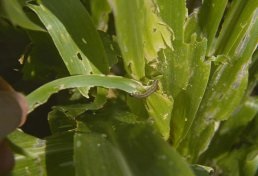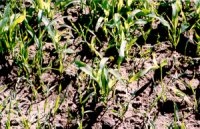Cover crops: other grasses
Information on the benefits and growth habits of corn, other grasses, fescues, and triticale planted as a cover crop.
Corn
Description
Family
- Annual grass.
Cover crop use
- After early harvested crops, when soil moisture and nitrogen available.
- Use discarded or old seed.
Growth habits
Germination
- A relatively large seed, it requires some moisture to get going.
- Needs warm soils, temperature greater than 10°C for germination and growth.
Top growth
- When planted as a cover crop will behave more like a grass like sorghum sudan.
Root system
- Fibrous.
Overwintering
- Winterkills.
Site Suitability
- Tolerant of most soil types, germination and emergence in mid to late summer on heavy clay soils challenging.
Control options
- Tillage, frost and burndown herbicides can be used for control.
Sensitivity to herbicides: Weed Control
- There are many herbicides registered for use in corn but good weed control for a cover crop should not be expensive and may not be needed. Use narrow rows and a high enough plant population to establish a vigorous crop canopy as soon as possible.
Benefits and concerns
- Corn can make an inexpensive and effective cover crop if seeded early. However it is very sensitive to frost. If seeding a fragile, erosion prone area, mix with a cover crop like rye or wheat to ensure that the cover is stable.
Nutrient management
- High uptake of soil nitrogen once past 3 to 4 leaf stage.
Pest management
- Some concern about harbouring corn pests like armyworm in late summer.
Organic matter
- Best used as a green manure crop.
- Biomass return highly dependent upon planting date, seeding rate and first frost.
Erosion control
- Not a good option.
Getting started
Establishment
- Plant similar to sorghum sudan.
- Use drill rather than rows to get fastest cover possible.
- Seed heavy to get fast cover and to compensate for low seed viability.
Cost and availability
- If discard seed available locally — seed should be inexpensive or free.
Fescues
- Often used in erosion control projects to stabilize banks and provide cover on buffer strips or grassed waterways.
- Also used for sod strips in orchard production.
- Low growing varieties greatly reduce the need for mowing.
Triticale
Description
Family
- Grass — Triticeae.
Cover crop use
- Similar to other spring cereals is using spring triticale.
- Winter triticale — overall ground cover after harvest, will establish late into the season.
- As a forage crop.
Growth habits
Germination and emergence
- Will germinate in cold temperatures –1 to 2°C but vegetative growth requires 4°C.
Top growth
- Taller than wheat, mature crop 120 to 150 cm in height.
- Warm wet weather in spring can cause rapid growth from 15 cm to 1 m in a short period of time.
- Long day plant — will flower when daylight hours exceed 14 hours and temperatures average 5 to 10°C.
- When flowering starts — vegetative growth stops.
Root system
- Fibrous.
- Extensive — can cover 1 m radius and 2 m depth of soil.
Overwintering
- Does not winter kill.
- As living tissue, there is greater resistant to sand abrasion over winter.
- Resumes growth in spring faster than wheat.
Site suitability
- More drought tolerant than wheat or oats.
- Tolerates a wide range of soil conditions but does best in well drained light soils — sands, loamy sands, sandy loams and gravelly soils.
Control options
- Can be harder to kill than other cereals — timing and control options are critical.
- Mow when crop goes into flowering stage (vegetative growth has stopped) for non-chemical control.
- Requires careful management of chemical control in the spring.
- Low rates of glyphosate can kill the plant — but leave it standing. This prolongs protective features longer. High rates of glyphosate will knock the crop down leaving less wind protection.
Sensitivity to herbicides: Weed control
- There are many herbicides registered for use in wheat but good weed control for a cover crop should not be expensive and may not be needed.
- Establish a vigorous crop canopy to smother out weeds.
Benefits and concerns
Nutrient management
- Best cool season cereal crop for taking up leftover nitrogen from previous manure application(s).
- Can tie up nitrogen in spring when needed by following crop.
- Rye may help to increase the concentration of potassium at the surface due to its extensive root system.
Pest management
- Competitive growth habits — good for suppressing weeds.
- Allelopathic effect — prevents weed germination and growth, but can have allelopathic effect on other grass-like crops (for example, corn).
Organic matter
- Large volumes of plant biomass returned to soil.
Erosion control
- Wind abatement strips.
- On tomato beds.
- As strips in tobacco or vegetable fields.
- Preferred because it does not winterkill and is resilient to sand blasting.
Soil moisture
- More drought tolerant than wheat or oats.
Getting started
Establishment
- Shade tolerant — can be overseeded into a standing crop of corn before leaf drop.
- Only cover crop that can be planted in the late fall and still provide some soil cover, although the protection may not be highly effective until early spring.
- Cold tolerant — established rye can withstand temperatures of –35°C.
Cost and availability
- Seed is relatively inexpensive and readily available.
Updated: January 15, 2025
Published: September 19, 2022

